Alternative gel based material red seaweed for ultrasonography examination
Main Article Content
Abstract
Background: Red seaweed extract of kappa and iota carrageenan is commonly used as a gel base. Kappa carrageenan is stiffed or breakable that may experience syneresis. Iota carrageenan has a softer gel texture, elastic, and has less possibility of syneresis, but not as strong as kappa carrageenan gel. Therefore, kappa and iota carrageenan can be mixed to obtain better gel properties and water-soluble. It will be proposed as a carrageenan-based ultrasound gel as acoustics connector, certainly in renal ultrasonography (USG) examination.
Objectives: To demonstrate the ability of gel made from red seaweed extract as an intermediary for ultrasonic waves in ultrasound examination.
Materials and methods: A quasi-experimental study with post-test only control group design to reveal the potency of red seaweed (carrageenan) extract as an alternative gel in renal USG examination. A total of 22 voluntary respondents were included in this present study.
Results: Red seaweed extract based gel can be used as an intermediary for ultrasonic waves in ultrasound examination. Quality of renal ultrasound image by a well-known manufactured carbomer-based ultrasound gel product (Gel A) compared to alternative carrageenan-based ultrasound gel (Gel B) was not different.
Conclusion: The finding is carrying an expectation to lift the potency of red seaweed extract as carrageenan-based ultrasound gel in renal ultrasonography (USG) examination. Considering its environmental friendly and inexpensive nature, carrageenan-based gel extracted from red seaweed can be proposed as an alternative ultrasound gel in renal ultrasonography (USG) examination.
Journal of Associated Medical Sciences 2017; 50(2): 307-313. Doi: 10.14456/jams.2017.31
Article Details

This work is licensed under a Creative Commons Attribution-NonCommercial-NoDerivatives 4.0 International License.
Personal views expressed by the contributors in their articles are not necessarily those of the Journal of Associated Medical Sciences, Faculty of Associated Medical Sciences, Chiang Mai University.
References
2. Brownlee I, Fairclough A, Hall A, Paxman J. The potential health benefits of seaweed and seaweed extract. In: Pomin, VH, (ed.) Seaweed: ecology, nutrient composition and medicinal uses. Marine Biology: Earth Sciences in the 21st Century. Hauppauge, New York, Nova Science Publishers, 2012; p119-36.
3. McHugh DJ. Production, properties and uses of alginates. Production and Utilization of Products from Commercial Seaweeds FAO Fish Tech Pap. 1987; 288: 58-115.
4. Zatnika A. Pedoman Teknis Budidaya Rumput Laut. Jakarta: Badan Pengkajian dan Penerapan Teknologi. 2009.
5. Necas J, Bartosikova L. Carrageenan: a review. Veterinarni Medicina. 2013; 58(4): 187-205.
6. Sudariastuty E. Pengolahan Rumput Laut. Sekolah Tinggi Perikanan Jakarta. 2011.
7. Ulfah M. Pemanfaatan Iota Karaginan (Eucheuma spinosum) dan Kappa Karaginan (Kappaphycus alvarezii) sebagai Sumber Serat untuk Meningkatkan Kekenyalan Mie Kering. 2009.
8. Campo VL, Kawano DF, da Silva DB, Carvalho I. Carrageenans: Biological properties, chemical modifications and structural analysis–A review. Carbohydrate Polymers. 2009; 77(2): 167-80.
9. Meena R, Prasad K, Siddhanta A. Development of a stable hydrogel network based on agar–kappa-carrageenan blend cross-linked with genipin. Food Hydrocolloids. 2009; 23(2): 497-509.
10. Ansel H. Pengantar Bentuk Sediaan Farmasi, edisi IV, diterjemahkan oleh Farida Ibrahim. Universitas Indonesia Press, Jakarta Hlm. 1985; 212: 269.
11. Buhse L, Kolinski R, Westenberger B, Wokovich A, Spencer J, Chen CW, et al. Topical drug classification. International journal of pharmaceutics. 2005; 295(1): 101-12.
12. Binkowski A, Riguzzi C, Price D, Fahimi J. Evaluation of a cornstarch-based ultrasound gel alternative for low-resource settings. The Journal of emergency medicine. 2014;47(1): e5-e9.
13. Goodsitt MM, Carson PL, Witt S, Hykes DL, Kofler J. Real-time B-mode ultrasound quality control test procedures. Report of AAPM Ultrasound Task Group No. 1. Med Phys. 1998; 25(8): 1385-406.
14. Nontji A. Laut Nusantara Djambatan. Jakarta; 1993.
15. Fardiaz D. Hidrokoloid. Laboratorium Kimia dan Biokimia Pangan, Pusat Antar Universitas Pangan dan Gizi, Institut Pertanian Bogor, Bogor. 1989.
16. Wulandari N. Penggunaan Kompleks Polielektrolit Gelatin-Karagenan Sebagai Basis Gel Topikal. Depok: Universitas Indonesia; 2012.
17. Palmer P. Panduan Pemeriksaan Diagnostik USG–World Health Organization. EGC, Jakarta. 2001.
18. van de Velde F, Lourenço ND, Pinheiro HM, Bakker M. Carrageenan: a food-grade and biocompatible support for immobilisation techniques. Advanced Synthesis and Catalysis. 2002; 344(8): 815-36.
19. Rowe RC, Sheskey PJ, Weller PJ. Handbook of pharmaceutical excipients: Pharmaceutical press London; 2006.
20. Barry BW. Dermatological formulations: percutaneous absorption. New York: M. Deker; 1983.


